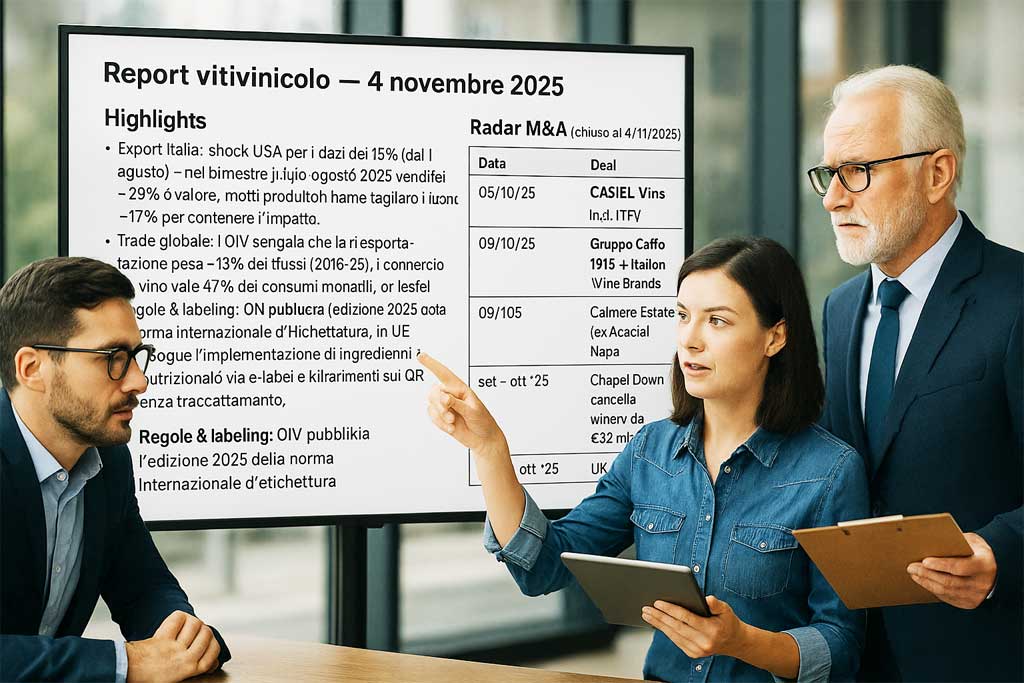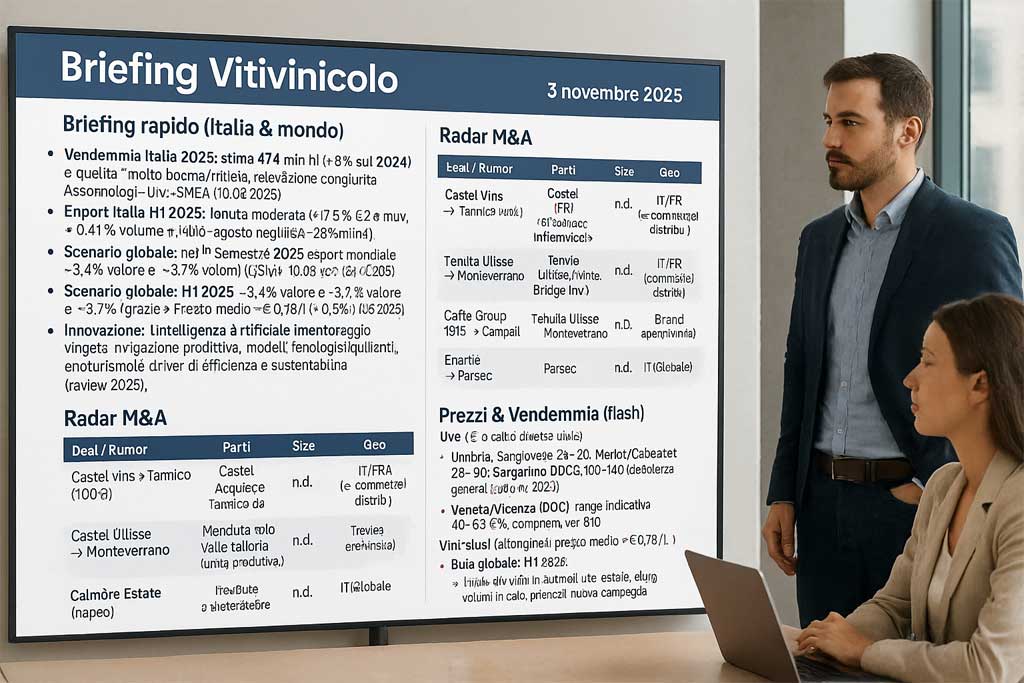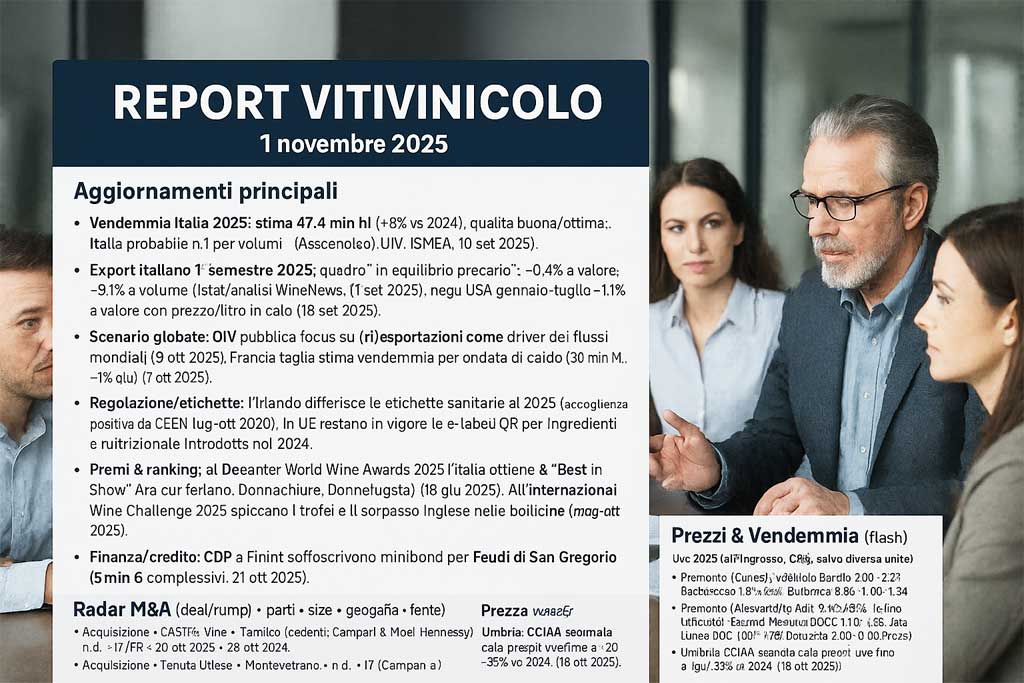Today’s wine and cellar trends,
Highlights (in 6 points)
- Italian exports: US shock from 15% tariffs (effective August 1) – sales down 28% in value in July-August 2025 ; many manufacturers have cut their price lists by ~ 17% to limit the impact. UIV calls for support measures.
- Italy 2025 harvest : official estimates of ~47.4 Mhl and good to excellent quality; other supply chain readings converge between 44–47 Mhl (widening due to heterogeneous yields in the North/Central-South). Inventories as of September 30: 36 Mhl (-9.6% vs. July; 1.3% vs. y/y).
- France : 2025 output revised downwards to ~ 36–37.4 Mhl due to summer heat and drought; some districts (Beaujolais) at multi-year lows, Champagne slightly recovering.
- Spain : 2025 estimate drops sharply to ~31–32 Mhl (Copa-Cogeca/SeVi), with DOs such as Rías Baixas at historic grape records.
- Global trade : the OIV reports that re-export accounts for ~ 13% of flows (2018-23); wine trade accounts for 47% of world consumption.
- Rules & Labeling : OIV publishes the 2025 edition of the international labeling standard; in the EU, the implementation of ingredients and nutritional information via e-label continues, along with clarifications on tracking-free QR codes . In Italy, a national framework for dealcoholized wine has been established (prohibitions for PDO/PGI).
M&A Radar (closed 4/11/2025)
| Date | Deal / Rumor | Parts | Size | Geo |
|---|---|---|---|---|
| 06/10/25 | Tannico moves to CASTEL-Vins (from JV Campari–Moët Hennessy) | Castel-Vins ↔︎ Tannic | nd | IT/FR |
| 09/10/25 | Binding offer for the Valle Talloria (IWB) site, the new “Casa Cinzano” | Caffo Group 1915 ↔︎ Italian Wine Brands | nd (closing expected by the end of 2025) | IT (Langhe) |
| October 25 | Calmére Estate (formerly Acacia), Napa sold to Asian investor | Peju Sellers ↔︎ Private Buyer | $16.8 million | USA (Napa) |
| September–October ’25 | Chapel Down cancels £32m winery (pivot capex) | Chapel Down | n/a | UK |
Prices & Harvest (flash to 4/11)
- GRAPES (€/kg) • Piedmont (AL–AT, 09/10) : Nebbiolo 1.00–1.35 ; Arneis 1.00–1.35 ; “non-varietal” 0.50–0.60 . • Cuneo (update of Chamber of Commerce portal) : Nebbiolo Barolo 3.00–3.21 ; Barbaresco 1.91–3.39 ; Moscato d’Asti 1.20–1.24 ; Barbera d’Alba 1.00–1.34 . • Prosecco – Treviso/BM and Condifesa : Glera DOCG indicative range 0.85–1.70 ; DOC 0.56–1.12 ; Superior organic; yields: DOCG 135 q/ha; DOC 180 q/ha .
- Bulk wine (€/L, Treviso BM – today) : Prosecco DOCG 2.55–2.75 ; Asolo DOCG 2.40–2.60 ; DOC 2.05–2.25 .
- Bulk (global) : Abundant supply in several basins; flexible negotiations pending the definition of EU harvest volumes and post-tariff US demand (indications from Ciatti/Global reports).
- Tuscany – indicative prices : 2022 bulk Chianti: €140–170/hl (Camera Firenze, 5/10); signs of correction on top DOCG grapes 2025 vs 2024 (BMTI analysis).
- Inventories : 36 Mhl as of 09/30/25 (−9.6% vs July; 1.3% y/y).
- Weather & Yields : In Italy, yields improved in Central and Southern Italy, but were more erratic in the North; in France, hot August conditions compressed volumes; in Spain, yields were revised downwards.
Markets & Channels
- USA : key market to contract for Italy in summer 2025 due to tariffs; attention to channel mix (on-trade more resilient than off-trade in some metropolitan areas) and targeted discounts.
- UK : Industrial restructuring (e.g., Chapel Down) signals caution regarding domestic demand for still wines; premium sparkling wines are more robust in large-scale retail trade.
- Awards & Lists : Wine Enthusiast ’s “ Top 100 Best Buys 2025 ” ranks 17 Italian wines among the best for quality/price (e.g. Moscato d’Asti 2024 Saracco #3).
- Trade structure : growing role of re-export hubs (value added through storage/bottling), useful for logistics and pricing strategies.
Regulation & Compliance (quick check)
- OIV 2025 label (updated international guidelines).
- EU e-label (Reg. 2021/2117) : mandatory ingredients and nutritional information; tracking-free QR code ; operational updates by 2025.
- Italy – (partially) dealcoholized wine : national framework 2025 with ban on PDO/PGI and labelling obligations (“dealcoholized / partially dealcoholized”).
Things to monitor (4Q25–1Q26)
- Bulk price curves for Italy/Spain after the harvest closes and a possible post-Holiday US promotional relaunch.
- Implementation of US tariffs and potential EU-US negotiations; impact on sparkling vs. still .
- Capex/reorganizations in UK and AU (Chapel Down; “Vinarchy” in AU) as a litmus test of demand.
B2B content ideas for wineries/consortia
- “US Anti-Tariff Plan: How to Defend the 2026 Margin” – dynamic price lists, country/channel allocations, use of re-export hubs and FX hedging.
- “2025 Harvest Between 44–47 Mhl: Inventory Management and Cash Flow” – Levers for Grape, Blend, Bulk↔Bottle Contracts, D2C E-commerce, and Q1 Campaigns.
- “Risk-Free Label 2025: Operational Checklist for e-Labels & QR Codes” – requirements, privacy audits, content governance, and localizations.





